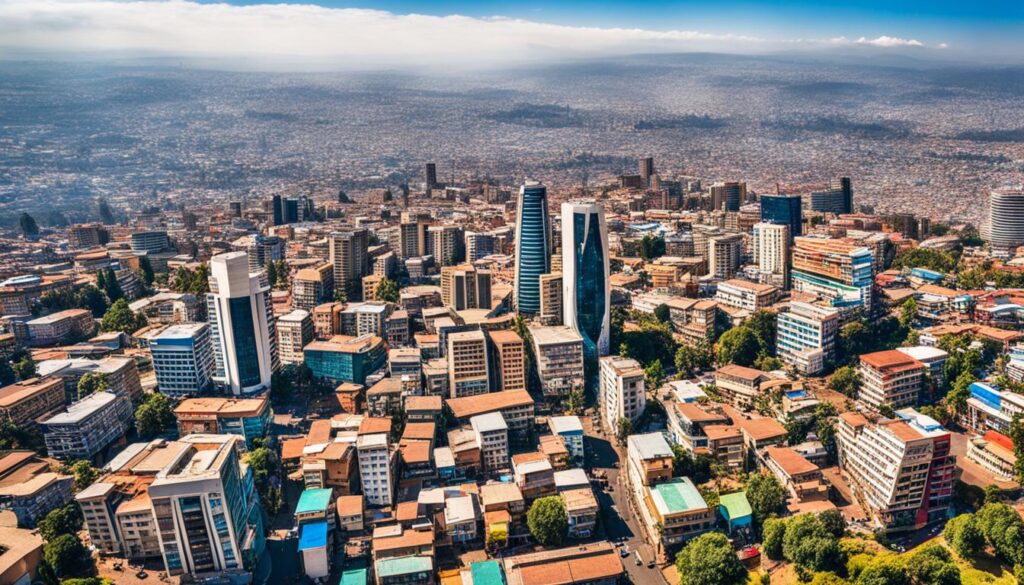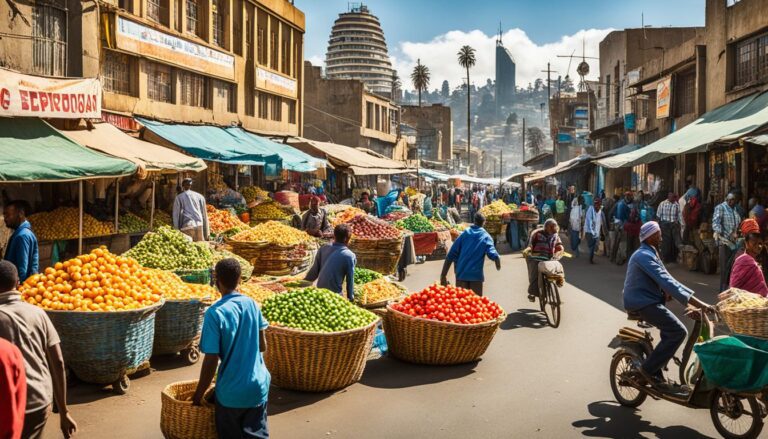How Many People in Addis Ababa?
Have you ever wondered how many people live in the capital city of Ethiopia? Addis Ababa is a bustling metropolis with a rich history and vibrant culture. As the largest city in the country, it serves as a hub of economic, administrative, and cultural activities. But just how many inhabitants does this vibrant city hold?
Stay with us as we delve into the fascinating world of Addis Ababa’s population. From its rapid growth to the latest demographic trends, we’ll uncover the secrets behind the city’s population size. Get ready to explore the nuances of this diverse city and discover the factors influencing its population growth.
Key Takeaways:
- Addis Ababa is the capital and largest city of Ethiopia.
- The city’s population has been steadily increasing over the years.
- Factors such as urbanization and economic opportunities contribute to the growth of Addis Ababa’s population.
- The city is known for its cultural diversity and religious tolerance.
- Addis Ababa plays a crucial role in Ethiopia’s economic growth and development.
The Growth of Addis Ababa’s Population
Over the years, Addis Ababa has experienced significant population growth. The city’s population has been growing steadily, with an annual growth rate estimated to be around 4.45%. This growth can be attributed to various factors, including urbanization, economic opportunities, and migration from rural areas to the city.
Addis Ababa’s population growth reflects the increasing urbanization in Ethiopia and the trend of people moving to cities in search of better livelihoods and opportunities. As the capital city, Addis Ababa serves as a hub for commerce, education, and governance, attracting individuals from all over the country. The city offers a wide range of employment opportunities, as well as access to education, healthcare, and cultural amenities.
The population growth of Addis Ababa has significant implications for urban planning and infrastructure development. As the city continues to grow, it becomes essential to address the challenges associated with increased demand for housing, transportation, and public services. The government and city planners are working towards sustainable urban development, focusing on improving transportation networks, expanding housing options, and creating green spaces.
Additionally, the growing population of Addis Ababa contributes to the economic growth of Ethiopia. The city is a major center for trade and commerce, attracting local and international businesses. With a larger population comes increased consumer demand, creating opportunities for entrepreneurs and investors. Addis Ababa’s population growth is closely linked to the overall development and progress of the country.
Demographics of Addis Ababa
Addis Ababa is a vibrant and diverse city, home to a rich tapestry of ethnic groups. The city encompasses a melting pot of cultures, with the largest ethnic group being the Amhara. They form a significant portion of the population, contributing to the city’s unique identity. Other prominent ethnic groups in Addis Ababa include the Oromo, Gurage, and Tigray, each adding their own distinctive flavor to the city’s fabric.
Language plays a significant role in Addis Ababa’s cultural landscape. The Amharic language is widely spoken, serving as the primary means of communication for the majority of the population. Oromo is the second most commonly spoken language, showcasing the city’s linguistic diversity. The multilingual nature of Addis Ababa fosters an inclusive and harmonious environment, where different languages intertwine, creating a beautiful symphony of voices.
Religion holds an important place in the lives of the city’s residents. Addis Ababa boasts a significant Orthodox Christian population, with approximately 82% of the people adhering to this faith. The city is adorned with magnificent Orthodox Christian churches, showcasing the religious devotion and architectural beauty. Alongside the Orthodox Christian community, Muslim and Protestant communities also contribute to the religious diversity of the city, fostering a sense of harmony and coexistence.
With its ethnic diversity, linguistic tapestry, and religious harmonization, Addis Ababa stands as a beacon of cultural tolerance and acceptance. The city’s demographics reflect the spirit of unity amidst diversity and serve as a reminder of the richness that comes from embracing different backgrounds and beliefs.
Image:
Historical Background of Addis Ababa

Addis Ababa, the capital city of Ethiopia, has a rich historical background that dates back to its founding in 1886. Emperor Menelik II played a pivotal role in establishing the city and choosing it as the capital. The emperor recognized the potential of Addis Ababa due to its favorable climate and abundant resources, surpassing the previous capital, Entoto.
Originally, Addis Ababa served as a resort town and quickly became a hub for nobilities, working-class individuals, and foreign visitors. In 1889, it officially became the capital of Ethiopia, solidifying its political and economic significance in the country. Since then, Addis Ababa has flourished and witnessed remarkable growth in various sectors.
Today, Addis Ababa stands as a testament to its vibrant history, boasting numerous historical landmarks and cultural sites that reflect its rich heritage. To fully appreciate the city’s historical significance, one can explore attractions such as the National Museum of Ethiopia, Holy Trinity Cathedral, and the Addis Ababa University.
Discovering the historical background of Addis Ababa offers a deeper understanding of this remarkable city and its evolution into the vibrant capital it is today.
Addis Ababa’s Urban Development

Addis Ababa’s urban development began in the 20th century without any prior planning. The city experienced rapid growth and urbanization, leading to the need for infrastructure development. Over the years, various master plans were designed by international consultants to meet the demands of the growing population and development. These plans focused on the construction of key monuments, civic structures, and the creation of satellite cities to accommodate the rapid expansion.
In the 1920s and 1930s, Addis Ababa witnessed significant economic growth, which resulted in the construction of modern buildings and the importation of European furniture and automobiles. The city’s urban landscape began to transform as it embraced modernization and sought to create a more livable environment for its residents.
Efforts to improve transportation, housing, and public spaces have been ongoing, with a focus on enhancing the overall urban experience. The goal is to create a well-planned city that meets the needs of its growing population and offers a high quality of life.
The image above showcases the progress made in urban planning and infrastructure development in Addis Ababa. Through carefully planned strategies and investments, the city is working towards creating a sustainable, vibrant, and inclusive urban environment.
Addis Ababa’s Future Population Growth
The future population of Addis Ababa is projected to continue growing. With an estimated annual growth rate of around 4.45%, the city is expected to see a significant increase in population. By 2025, it is estimated that Addis Ababa will exceed 6.5 million residents.
This future population growth is driven by various factors, including urbanization trends, economic opportunities, and the city’s attractiveness as a hub for different industries. Addis Ababa’s population growth reflects the overall growth and development of Ethiopia as a whole.
The capital city plays a crucial role in the country’s economic growth and continues to attract migrants from rural areas and other regions. As urbanization continues to shape the landscape of Addis Ababa, the city’s future population projections remain promising.
For more information on the population growth and urban development of Addis Ababa, continue reading our comprehensive article.
Conclusion
Addis Ababa, the capital city of Ethiopia, is experiencing significant population growth, driven by urbanization and economic development. The city serves as the headquarters of major international organizations and is a vibrant center for culture, art, and administration. This diverse city attracts people from various backgrounds, contributing to its rich cultural fabric.
With ongoing urban development and infrastructure improvements, Addis Ababa is well-positioned for further growth and development in the future. The city’s population has been steadily increasing, reflecting the overall progress happening in Ethiopia. As urbanization continues and economic opportunities expand, Addis Ababa will continue to be a magnet for migrants from rural areas and beyond.
As Ethiopia’s capital, Addis Ababa plays a pivotal role in the country’s economic growth. The city’s strategic location and status as a hub for international organizations make it an attractive destination for businesses and individuals alike. With its enticing blend of cultural diversity, economic prospects, and ongoing efforts to improve urban facilities, Addis Ababa is poised to thrive as a vibrant and thriving metropolis.






